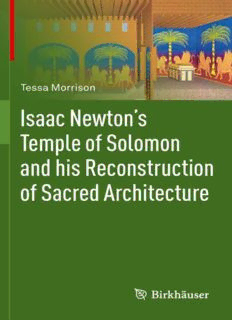
Isaac Newton's Temple of Solomon and his Reconstruction of Sacred Architecture PDF
Preview Isaac Newton's Temple of Solomon and his Reconstruction of Sacred Architecture
Tessa Morrison ’ Isaac Newton s Temple of Solomon and his Reconstruction of Sacred Architecture TessaMorrison TheUniversityofNewcastleCallaghan TheSchoolofArchitectureandBuiltEnvironment Newcastle,Callaghan Australia [email protected] ISBN978-3-0348-0045-7 e-ISBN978-3-0348-0046-4 DOI10.1007/978-3-0348-0046-4 #SpringerBaselAG 2011 Thisworkissubjecttocopyright.Allrightsarereserved,whetherthewholeorpartofthematerialis concerned,specificallytherightsoftranslation,reprinting,re-useofillustrations,recitation,broadcasting, reproductiononmicrofilmsorinotherways,andstorageindatabanks.Foranykindofuse,permissionof thecopyrightownermustbeobtained. Coverdesign:deblik,Berlin Printedonacid-freepaper SpringerBaselAGispartofSpringerScienceþBusinessMedia www.birkhauser-science.com Foreword Architecture is certainly not a field that comes to mind when we think of Isaac Newton.Thisispreciselywhythispresentvolumeissoimportant.Itnotonlyshows usalittleknownsideofoneofthegreatestmindsinhumanhistory,butalsohelpsus understandentireareas ofinquirythathavefallen intooblivion, thoseof“chronol- ogy”and“ancientwisdom”. Becauseweareallintelligentbeings,intelligenceitselfisofinteresttous.Genius, whichissuperlativeintelligence,isgreatlyinterestingtous.Butbecausegeniusisnot alwaysaccessible,mythtakesover.ThisisastrueforhistoricalfigureslikeNewton andLeonardodaVinci,asitisformorerecentgeniuses,likeEinstein:thescientistis obscuredbythemyth. InthecaseofLeonardo, themythgrew tosuchproportions that the tendency is to credit Leonardo with the invention or prototype for almost everything, in spite of the fact that in many cases careful study of his notebooks demonstratesthat,evenwhenhecorrectlyobservedthephenomenahewasstudying, hedrewthewrongconclusions,orwhen,intheattempttobuildhis“inventions”,they arediscoveredtohaveirremediableflaws.ThecaseofNewtonisjusttheopposite. Newton’s myth was forged by neglecting or denying the activities that actually occupiedthelargestpartofhisintellectuallife.Recentinterventionshaveaimedat restoring to Newton the parts of this work that earlier periods had deemed unim- portantorevenscandalous.Thispresentworkfallsinthatcategory. Uncoveringandmakingaccessibletheworkofscientistsandscholarsofthepast is much more difficult than it might appear to be. Newton himself knew that: had these challenges been easy, he needn’t have spent a lifetime working on ideas surroundingchronology,ancientwisdomorSolomon’sTemple. Oneoftheobstaclesislanguage.Inordertointerpretthebiblicalpassageshewas interested in, Newton had to grapple with the Hebrew. But for many of today’s scholars,aLatintextpresentsequaldifficulties.Latinwas,ofcourse,thelanguageof scholars. Not having had an education of the kind reserved to young noblemen, Leonardo da Vinci found that many mathematical and scientific treatises remained closedtohimbecauseoftheLatin,buttheyareequallyclosedtotoday’sscholars.In ourpresentage,knowledgeofLatinislimitedalmostexclusivelytospecialists.Even NewtonrecognisedthelimitsofLatin.Hehimselfwasinterestedinthecreationofan international language that could more accurately interpret the prophets that con- cernedhim. v vi Foreword However, knowledge of the language is only one of the requisites for accurate translation; the other is knowledge of the subject. All translations are essentially interpretations.Ifthetranslatorisnotknowledgeableinthefield,wearelikelytofind everygenreofmistake. Another obstacle to retracing lost ideas is related to the cultural changes that separateoneepochfromanother.Accordingtoonetheory,wecannevercompletely understandanearlierage,becausewemustinevitablyfilterwhatwereadaboutthat agethroughourownculturalalignment,thatis,itisimpossibleforusto“unlearn” whatweknowsothatwecanapproachtheideasthatcamebeforeus,andthereforeall ofwhatwethinkaboutearlieragesiscontaminatedbyourown.Ifwecarrythattoits logicalextreme,ofcourse,itmakesnosensetostudyhistorybecausewecan’tknow what ideas meant in an earlier age. This would doom us to a perpetual present, flatteningoutourexperience.Butwecan’tgototheotherextremeeither,takingitfor granted that there are no cultural gaps. In the case of the seventeenth century, for instance, it is almost impossible for us to grasp how thoroughly Christianity per- meatedallaspectsofcultureandsociety.ButinordertounderstandNewton,wemust try to understand what that must be like, even if we are all the more surprised that religionwouldhavesuchanoverwhelminginfluenceontheverymindweholdtobe theparadigmofscientificthinking. Culture also determines what areas of inquiry are deemed to be of the greatest importance. Our scientific age nods in agreement with Newton’s contemplation of mathematics and physics, but finds it harder to countenance inordinate amounts of time and effort given to alchemy and interpretation of the prophets. We apparently agree with Newton that history is important, but we may disagree with just what about it is important. Newton concerned himself with “chronology”, that is, the science of computing time or periods of time (not to be confused with measuring time),anareaofinquirythatbegantofadearoundtheturnoftheeighteenthcentury. Inanagethatwasfamousforitsscientificdisputes,Newtonwasperhapsthemost polemic figure of all. His dispute with Leibniz over the discovery of calculus is legendary.HiseffortstotakerevengeonRobertHookeandconsignhimtooblivion arealsowellknown.Soitcomesasnosurprisetoreadthathisresultsin“chronol- ogy”werehotlycontestedaswell. Bynow,however,youcanseehowmanylayershavetobegonethroughtoreach some kind of understanding of Newton and his more esoteric interests. Tessa Morrison may well be the only scholar knowledgeable enough in both the Latin andthisparticularmaterialtomakeherwaythroughit.Inhavingmadetheeffort,she has given us back a part of Newton that we were seriously in danger of losing altogether. Ifthisbookweremerelyatranslation,however,itwouldberatheradryacademic exercise. What makes it especially significant is the commentary, which inserts Newton’s manuscript into its proper context within the ongoing discussion about relationships between architecture and mathematics. While the Bible does contain someinformationaboutmeasurements,itisnotoneofthemostprecisedocumentsin thisrespect.ItisfascinatingtolearnthatNewtonwasatpainstodeterminetheexact length of the cubit. Even more fascinating is that Newton studied Vitruvius and Foreword vii derived his own Vitruvian man. Thus Newton is given his rightful place in the traditionofarchitecturalthinkerssuchasAlbertiandLeonardo.Further,hiscriticism andrevisionofVillalpanda’sreconstructionofSolomon’stempleshowshimtobean acutearchitecturalanalyst. Asatranslatorandcommentator,Dr.Morrisondoesaremarkablejobofkeeping herself off the page. But Newton scholarship, as well as that on architecture and mathematics,isgreatlyenrichedbyeffortssuchasthese,andwecanbegratefulthat shehasdedicatedhertimeandattentiontobringthispresentworktoournotice. EditorinChief,NexusNetworkJournal KimWilliams Turin,Italy Acknowledgements Iwishtoexpressmygratitudetomymanyfriendsthathaveofferedsupportinthe writingofthisbook,inparticularAndrewStephensonandJulianPoulterfortheir suggestionsandtoNingGuandJosephineVaughanfortheirveryusefuladviceon the3DmodellingprogramArchiCAD.Inthisproject,Ihaveusedawiderangeof Newton’sunpublishedmanuscriptswhichhavebeengenerouslymadeavailableby many libraries. I would particularly like to thank the Babson College Library for makingpublicanexcellentreproductionofBabsonMS0434ontheirwebsite.To view the reproduction of the manuscript see http://www3.babson.edu/Archives/ newton_collection/MS434C.pdf. Also thanks to The Newton Project at the University of Sussex for making many manuscripts public that would have been formallyunobtainable.Furthermore,IwishtothankKimWilliamswhoprovideda personal preface for this work; also to my husband John for his continuous, invaluablesupportandassistancewhichIcouldnotdowithout. Callaghan,NSW,Australia TessaMorrison ix
Description: